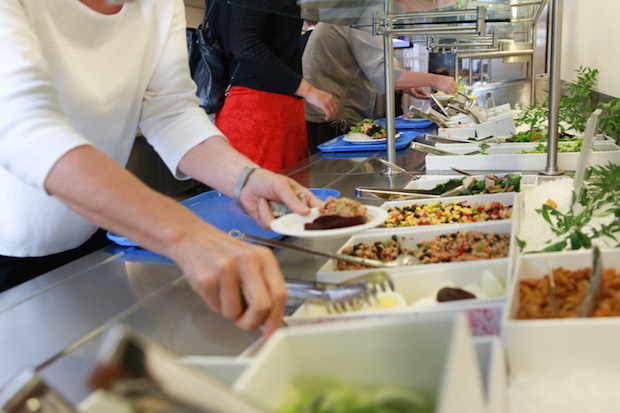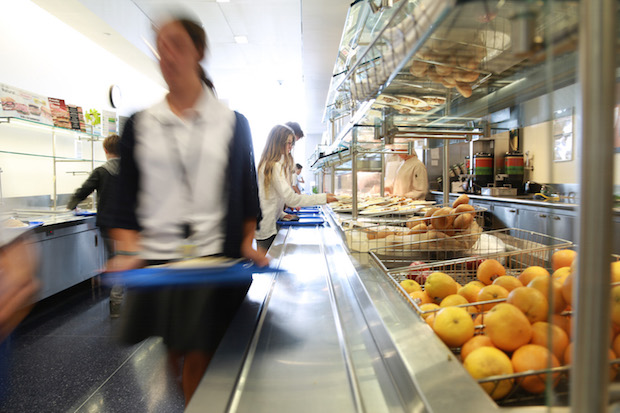Our daily nutrition is essential to healthy living. What we eat has a direct effect on how we perform and feel each day. Nutrients are the components of food that help us grow and give us the energy. Food is considered either nutrient-dense or not, and we don’t always choose the right balance of these essential nutrients, which can cause us either to feel exhausted or energized. There are five major nutrients that we need to feel well balanced and healthy: carbohydrates (fruits, vegetables, whole wheat breads, pastas and cereals), fats (extra virgin olive oil, avocados), proteins (lean meats and fish), vitamins and minerals (nuts, beans, lean meats, fruits, vegetables).
 [1]
[1]
The cafeteria at the LFNY feeds students, faculty and staff every day. It has a full salad bar, a sandwich as well as a hot meal station.
When eating or drinking, students should recognize that what they are consuming has a certain amount of calories. Proper caloric intake is usually measured by an individual’s amount of activity. In other words, the more activity that you do, the more calories you should consume. An athlete, for example, might take in more calories than a non-athlete, simply because of the burning of calories through athletic activity. Nutritionists generally agree that the average intake for a non-active teenage boy should be somewhere between 1800-2000 daily calories. Compared to an active teenage boy, which requires between 2400 to 2800 daily calories. A non-active teenage girl needs about 1600 to 1800 daily calories, while active teenage girls require about 2200 to 2400 daily calories in order to maintain a healthy weight and energy.
A banana after working out
People who participate in any physical activity burn calories and lose water and electrolytes through sweat. It is imperative to replenish those lost fluids with either water or, if needed, a sports drink. The major electrolytes lost are potassium, sodium and calcium. These electrolytes are the minerals responsible for regulating nerve and muscle function. A small electrolyte imbalance can cause fatigue, dehydration and cramping. For example, snacking on a banana before, during or after an activity can help replenish potassium lost through sweat.

Whenever possibly, the LFNY cafeteria sources fruits (such as apples) and vegetables locally.
It is also important to remember that we get calories from food and also from beverages, and beverage choices should be made carefully; whether it is morning coffee, or soda during lunch, hydration choices affect energy levels and also can increase daily caloric intake. For example, an energy drink may give a quick boost of energy, but the high amounts of sugar and caffeine are not only considered empty calories but also may lead to dehydration and cramping. Choose water (!) on a daily basis and when performing more strenuous activities, a sports or vitamin drink is also an option.
In conclusion, be conscious of what you put into your body in order to get the most out of it! Drink plenty of water, and eat fruits and vegetables to keep the body well-hydrated and energized.
Sample Healthy Choice menu
Breakfast: Whole grain cereal with low fat milk and a banana.
Lunch: Whole wheat sandwich with turkey lettuce and tomato
Dinner: Grilled chicken with brown rice and a side of broccoli.
Breakfast: Oatmeal with chopped strawberries on top.
Lunch: Grilled chicken salad with oil and vinegar dressing
Dinner: Salmon with quinoa and grilled mixed vegetables.
Breakfast: Egg white omelet with pepper, onions and turkey
Lunch: Tuna fish sandwich on whole wheat bread.
Dinner: Whole wheat pasta with a side of grilled chicken and steamed vegetables
Snacks: Cliff bars, piece of fruit, low fat chocolate milk, protein shake, low fat yogurt, granola bar and multigrain bars.
“Have this and not that” Healthy Alternatives
Instead of having a hamburger eat a grilled chicken sandwich.
Instead of soda drink water or a low-calorie sports drink.
Instead of cookies have a low fat cereal bar.
Instead of a milkshake you can drink low fat chocolate milk.
Instead of fried fish you can eat grilled or broiled fish.
Instead of white rice have brown rice.
Instead of pasta have whole-wheat pasta.
Instead of sugary cereals have oatmeal.
Instead of a potato with butter have a sweet potato.
Instead of candy have a piece of fruit.
Instead of croissant have a whole-wheat slice of bread or bagel.
Instead of coffee have a cup of green tea.
Read more:
Eating tips for teenagers: http://www.betterhealth.vic.
Tips for teen girls: http://www.choosemyplate.gov/
Tips for teen boys: http://www.choosemyplate.gov/
Sport and nutrition (in French):
http://www.ilosport.fr/
http://www.ilosport.fr/
Pourquoi votre enfant doit impérativement petit-déjeuner [7], écrit par l’infirmière du LFNY.
About the Author :
Angelo Annunziato works in partnership with LFNY coaches to better prepare athletes for games and matches. He is specialized in injury prevention, nutritional advice, warm-ups, and stretching.